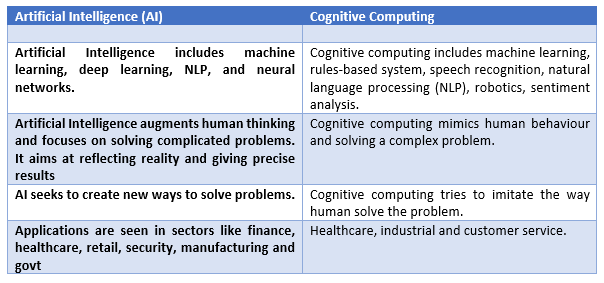What is cognitive computing?
Cognitive computing can be defined as the field of computer science that mimics the function of the human brain through natural processing language, data mining and pattern recognition. Cognitive computing forms a part of intelligence and is related to explaining complicated problems that may have dynamically changing circumstances and information-rich data that tend to change and, at times, conflict with each other. For human beings, they can tackle such problem by means of changing the goals and objectives. However, when it comes to computers, it is difficult for traditional computing algorithm to adapt to such situation. However, this has been now made possible via cognitive computing. Cognitive computing assesses the conflicting data and accordingly suggest the best answer that suits the situation.
How does cognitive computing work?
Cognitive computing integrates data from various sources. It then weighs the context and conflicting evidence to respond to the question. To achieve this goal, a cognitive system with self-leaning technologies via data mining, pattern recognition, and natural processing language understand how the human brain works.
In order to enable computers to work like the human brain require massive structured and unstructured data. The cognitive system gradually learns how to detect the pattern and the method of processing data & become efficient in anticipating the new problem and shaping a feasible solution.
What are the features of cognitive computing?
Cognitive computing involves the creation of a computer framework capable of solving complex problems without human interference. Thus, to implement the cognitive function in various applications, the cognitive computing consortium recommended a couple of features discussed below for the computing systems.
Adaptive:
Adaptive is the initial move in creating a machine learning-based cognitive system. The solution must be such that it mimics a human brain's capability to learn & adjust to the surroundings. In simple words, it is challenging to program a system for a particular task. Hence, the system needs to be dynamic with respect to collecting data, understanding goals and the requirement.
Interactive:
Like a human brain, the cognitive solutions must interact with other elements in the system like devices, processors, cloud, and human beings. These systems should interact bi-directionally and understand human input and provide appropriate outcome with the help of natural processing language and deep learning.
Iterative & stateful:
The system should be such that it can remember the previous interactions in the process and return information that fits the specific application at a particular time. It should define the problem either by asking questions or looking for more sources. The feature requires careful application of data quality along with validation methodology to ensure that the system has ample information and its data sources which it uses to provide output, are updated.
Contextual:
The cognitive systems are capable of understanding, identifying and extracting contextual elements like meaning, time, location, user profile, tasks, goals etc.
What is the difference between artificial intelligence and cognitive intelligence?
People generally consider artificial intelligence and cognitive computing interchangeable. However, there is a big difference between the two. Let us look at the difference between the two:

Application of Cognitive computing:
Cognitive computing is capable of doing a task that humans can do. However, there are other areas as well where we can see the application of cognitive computing.
Creating new product categories:
Cognitive computing not only helps to improve the product and services, but it can also bring about new classes of product and services that can create a new market and generate huge gains for investors. An example of this is the product launched by Vantage software which is based on IBM Watson's cognitive computing technology.
Through this product, the user can study a number of pages of the document, explore available market intelligence, risk profiles and financial profile data and obtain improved information to analysts.
Automating internal processes:
Cognitive computing is used for automation. Because of automation, the task done by the users is now taken care of by the computers. The result is obtained at a faster rate.
Cognitive technologies can automate task by enhancing worker or by substituting them. By the term augmenting, we mean supporting workers to do the job at a better and faster rate. An example of this is the automated voice response system that has substituted human customer service agents for first-level customer support. Another example of this technology is driverless trucks for mining.
Creating insight:
Another application of cognitive computing is in creating insight. For example, natural processing language technique has made it possible to analyse a huge volume of unstructured textual information. Through machine learning, it is possible to derive a conclusion from the large, complex dataset and provide superior predictions out of the operational data.
This technology is being used by various companies from reducing cost, improve efficiency, increase revenue, efficiency and enhance customer service.
Drawbacks of Cognitive Computing:
- One of the major drawbacks of this technology is the security concerns as digital devices handle crucial information in cognitive computing.
- Another concern related to this technology is that it is deliberately chosen by the individual, businesses, and the government.
- Cognitive Computing systems and products have a longer development cycle.
- It has created fear amongst people of losing their jobs.
 Please wait processing your request...
Please wait processing your request...